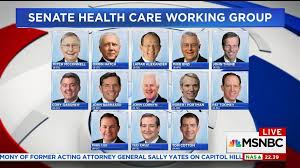Why the Senate Healthcare Plan Looks Like Obamacare 2.0

The healthcare reform bill recently passed by the House had a radical mission. Its pointed goal: To prevent an spending explosion from a new entitlement, and curb future budget deficits poised to soar starting around 2022. Last week at a luncheon with GOP senators, President Trump, who’d previously lauded the measure—often referred to as “Trumpcare”—reportedly assailed the legislation championed by Speaker Paul Ryan as “mean, mean, mean.”
On June 22, the Republican leadership unveiled its own version of healthcare reform. And in stark contrast to the House bill, it basically restores the methodology that made Obamacare an open-ended entitlement. Put simply, the House version protected the budget and unloaded most of the risk on folks buying policies in the individual market; the Senate’s measure––like Obamacare––shields folks fast-rising premiums, but puts America’s fiscal house at risk.
Here’s how the Senate bill undercuts the House objectives, and amounts to a somewhat less spendthrift “son of Obamacare.”
It’s crucial to examine the formula used to calculate the “tax credits” offered under Obamacare versus the two GOP plans. That’s because the generosity, or stinginess, of those credits is a major factor in the shaping future spending, and also determines how much folks will need to pay from their own household incomes. Under Obama’s ACA, those credits are indexed to income, and they’re especially large for the pre-Medicare elderly. For example, an 60-year old earning $ 42,000 a year pays no more than 9.7% of his or her income towards their insurance premium. So if the policy costs $ 12,000, the US treasury pays $ 7,900, and the individual $ 4,200 (or 9.7% of his or her $ 42,000 income).
Under the House AHCA, that relatively lavish subsidy would shrink shockingly. That elderly individual would receive a fixed credit of $ 4,000 that’s determined exclusively by age, and is totally unrelated to his or her income. It gets worse. The elderly person’s premium would also be higher than under the ACA, because the AHCA would allow insurers to charge the elderly 5 times as much as young people, versus a limit of three times mandated under Obamacare. If the 60-year old’s AHCA premium is $ 14,000 ($ 2,000 higher than under the AHCA), he or she would pay not $ 4,200, but $ 10,000 from their own pocket. Ouch!
The Senate bill, however, restores the link between income and the cost borne by individuals and families, marking a sharp departure from the House ethos. Once the new credits are fully phased in by 2020, that 60-year old would be required to contribute 16.2% of his or her income toward that policy. Once again, the Senate version allows insurers to charge the elderly a lot more than the young (also raising the ratio to five times). So in our example, the premium would remain at $ 14,000 as under the AHCA, but the tax credit would rise from $ 4,000 to $ 7,200—more than a 75% increase over the House plan.
Our elderly customer would then pay $ 6,800 from their take-home pay, a lot less than the $ 10,000 required under the House bill. But that’s still a lot more than the $ 4,200 out-of-pocket payment under Obamacare.
So the Senate plan is a lot more generous than the House version right from the start. But here’s the crucial difference: If that $ 14,000 plan costs $ 16,000 in a year, and his or her income stays flat, the government is obliged to pay the entire difference of $ 2000 in the Senate version. Under the Ryan measure, the increase falls entirely on the customer.
Put another way, the pressure is back off individuals and back on the federal budget. Welcome to Obamacare 2.0.
